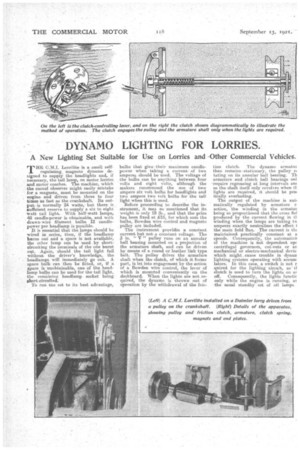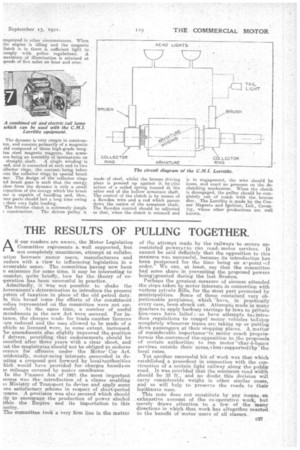DYNAMO LIGHTING FOR LORRIES.
Page 22

Page 23

If you've noticed an error in this article please click here to report it so we can fix it.
A New Lighting Set Suitable for Use on Lorries and -Other Commercial Vehicles.
THE CALI. Lorrilite is. a small selfregulating. magneto dynamo designed to supply the headlights and, if necessary, the tail lamp-, on motor lorries and motor coaches. The machine, which the casual observer might easily mistake for a magneto, must be mounted on the engine and driven from three to four times as fast as the crankshaft. Its output is normally 24 watts, but there is sufficient reserve to supply a six to eight watt tail light. With half-watt lamps, 48 candle-power is obtainable, and with drawn-wire filament bulbs 12 candlepower per headlamp is possible. It is essential that the lamps should be wired in series, then, if the headlamp burns out arid a spare is not available, the other lamp can be used by shortcircuiting the terminals of the one burnt out. Again., should the tail light fail without the driver's lmowledge, the headlamps will immediately go out. A spare bulb can then be fitted, or' . if a spare is unobtainable, one of the headlamp bulbs can be used for the tail light., the remaining headlamp socket being short-circuited.
To. run the set to its best advantage,
bulbs that give-their maximum candlepower when taking a current-of two amperes should be used. The voltage of the bulbs can be anything between four volts and eight volts, although the makers recommend. the use of two ampere six volt bulbs for headlights and two ampere two volt bulbs for the tail light when this is used.
-Before proceeding to describe the instrument, it may be mentioned that its weight is only 18 lb., and that the price has been fixed at 215, for which sum the bulbs,. Bowden wire control and magneto pulley are included. The instrument provides a constant current but not a constant voltage. The 3 in. "V' pulley runs on an annular ball bearing mounted on a projection of the armature shaft, and can be driven by means of a round or leather link type belt, The pulley drives the armature shaft when the clutch, of which it forms part, is let into engagement-by the action of a Bowden wire control, the lever of which is mounted conveniently on the dashboard. When the lights are not required, the dynamo is thrown out of operation by the withdrawal of the fric tion clutch. The dynamo armatur then remains ,stationary, the pulley rt tating on its annular ball bearing. Th armature and clutch ball bearings onl -require regreasing at long intervals am as the shaft itself only revolves when th lights are required, it should be pre, tically everlasting.
The output. of the machine is anti rnatically regulated by armature r action, the winding in the arinatin being so proportioned that the cross fiel produced by the current flowing in ti winding when the lamps are taking tvt amperes exactly neutralizes the effect 1 the main field flux. The current is tin maintained practically constant at a speeds. Consequently, the automaticil of the machine is not dependent ups centrifugal governors, cut-outs or an mechanical or electro-mechardcal devie. which might cause trouble in dynan lighting systems operating with accurir lators. In this case, a switch is not r quired for the lighting circuit, as if clutch is used to turn the lights on ar off. Consequently, the lights functir only while the engine is running, am the usual standby set of oil lamps.
employed in other circumstances. When the engine is idling and the magneto hutch is in there is sufficient light to .7omply with police regulations. A maximum of illumination is attained at ipeeds of five miles an hour and over.
The dynamo is very simple in construeion, and consists primarily of a magnetic eld composed of three high-grade tungten steel magneto magnets, the armsare being an assembly of laminations on straight shaft. A single windingis sed, and is connected at each end to two ()Hector rings, the currenb being taken :.om the collector rings by special brush ear. The design of the collector rings nd brush gear is such that the energy. Oren from the dynamo is only small rOportion of the energy which the brush ear is capable of handling and, thus, lese parts should last a long time owing ) their very light loading.
The friction clutch is extremely simple construction. The driven pulley is made of steel, whilst the bronze driving plate is pressed up against it, by-z,the action of a coiled spring housed at the other end of the hollow armature shaft. The control of the clutch is by means of a Bowden wire and a rod which passes down the centre of the armature shaft. The Bowden control should be adjusted so that, when the clutch is released and is in engagement, the wire should be loose, and exert no pressure on the declutching mechanism. When the clutch is disengaged, the pulley should be completely out ; of touch with the. bronze disc. The Lorrilite is made by the Conner Magneto and. Ignition, Ltd., Coventry, whose other productions are well known.
































